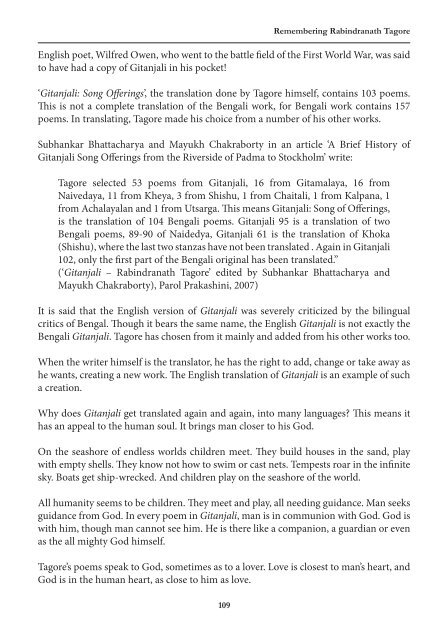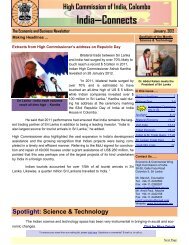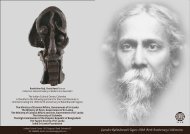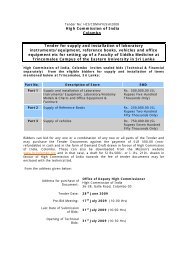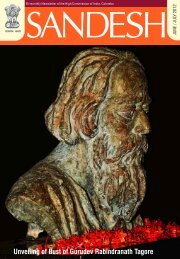Remembering Rabindranath Tagore Volume - High Commission of ...
Remembering Rabindranath Tagore Volume - High Commission of ...
Remembering Rabindranath Tagore Volume - High Commission of ...
You also want an ePaper? Increase the reach of your titles
YUMPU automatically turns print PDFs into web optimized ePapers that Google loves.
109<br />
<strong>Remembering</strong> <strong>Rabindranath</strong> <strong>Tagore</strong><br />
English poet, Wilfred Owen, who went to the battle field <strong>of</strong> the First World War, was said<br />
to have had a copy <strong>of</strong> Gitanjali in his pocket!<br />
‘Gitanjali: Song Offerings’, the translation done by <strong>Tagore</strong> himself, contains 103 poems.<br />
This is not a complete translation <strong>of</strong> the Bengali work, for Bengali work contains 157<br />
poems. In translating, <strong>Tagore</strong> made his choice from a number <strong>of</strong> his other works.<br />
Subhankar Bhattacharya and Mayukh Chakraborty in an article ‘A Brief History <strong>of</strong><br />
Gitanjali Song Offerings from the Riverside <strong>of</strong> Padma to Stockholm’ write:<br />
<strong>Tagore</strong> selected 53 poems from Gitanjali, 16 from Gitamalaya, 16 from<br />
Naivedaya, 11 from Kheya, 3 from Shishu, 1 from Chaitali, 1 from Kalpana, 1<br />
from Achalayalan and 1 from Utsarga. This means Gitanjali: Song <strong>of</strong> Offerings,<br />
is the translation <strong>of</strong> 104 Bengali poems. Gitanjali 95 is a translation <strong>of</strong> two<br />
Bengali poems, 89-90 <strong>of</strong> Naidedya, Gitanjali 61 is the translation <strong>of</strong> Khoka<br />
(Shishu), where the last two stanzas have not been translated . Again in Gitanjali<br />
102, only the first part <strong>of</strong> the Bengali original has been translated.”<br />
(‘Gitanjali – <strong>Rabindranath</strong> <strong>Tagore</strong>’ edited by Subhankar Bhattacharya and<br />
Mayukh Chakraborty), Parol Prakashini, 2007)<br />
It is said that the English version <strong>of</strong> Gitanjali was severely criticized by the bilingual<br />
critics <strong>of</strong> Bengal. Though it bears the same name, the English Gitanjali is not exactly the<br />
Bengali Gitanjali. <strong>Tagore</strong> has chosen from it mainly and added from his other works too.<br />
When the writer himself is the translator, he has the right to add, change or take away as<br />
he wants, creating a new work. The English translation <strong>of</strong> Gitanjali is an example <strong>of</strong> such<br />
a creation.<br />
Why does Gitanjali get translated again and again, into many languages? This means it<br />
has an appeal to the human soul. It brings man closer to his God.<br />
On the seashore <strong>of</strong> endless worlds children meet. They build houses in the sand, play<br />
with empty shells. They know not how to swim or cast nets. Tempests roar in the infinite<br />
sky. Boats get ship-wrecked. And children play on the seashore <strong>of</strong> the world.<br />
All humanity seems to be children. They meet and play, all needing guidance. Man seeks<br />
guidance from God. In every poem in Gitanjali, man is in communion with God. God is<br />
with him, though man cannot see him. He is there like a companion, a guardian or even<br />
as the all mighty God himself.<br />
<strong>Tagore</strong>’s poems speak to God, sometimes as to a lover. Love is closest to man’s heart, and<br />
God is in the human heart, as close to him as love.


